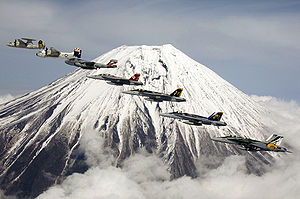
The 3rd Carrier Air Group was an aircraft carrier air group of the Royal Navy's Fleet Air Arm. It was formed in August 1945, based at HMS Nabbington, a Royal Navy, Mobile Naval Operating Air Base (MONAB), established at the Royal Australian Air Force (RAAF) base RAAF Nowra at Nowra, New South Wales, in Australia.

The Independence-class aircraft carriers were a class of light carriers built for the United States Navy that served during World War II.

HMAS Sydney (R17/A214/P214/L134) was a Majestic-class light aircraft carrier operated by the Royal Australian Navy (RAN). She was built for the Royal Navy and was launched as HMS Terrible (93) in 1944, but was not completed before the end of World War II. The carrier was sold to Australia in 1947, completed, and commissioned into the RAN as Sydney in 1948.

Operation Hailstone was a massive United States Navy air and surface attack on Truk Lagoon on 17–18 February 1944, conducted as part of the American offensive drive against the Imperial Japanese Navy in the Pacific Ocean theatre.

Captain David McCampbell was a United States Navy captain, naval aviator, and a Medal of Honor recipient. He retired from the navy in 1964 with 31 years of service.
Commodore was an early title and later a rank in the United States Navy, United States Coast Guard and the Confederate States Navy, and also has been a rank in the United States Public Health Service Commissioned Corps and the National Oceanic and Atmospheric Administration Commissioned Officer Corps and its ancestor organizations. For over two centuries, the designation has been given varying levels of authority and formality.

A carrier air wing is an operational naval aviation organization composed of several aircraft squadrons and detachments of various types of fixed-wing and rotary-wing aircraft. Organized, equipped and trained to conduct modern US Navy carrier air operations while embarked aboard aircraft carriers, the various squadrons in an air wing have different but complementary missions, and provide most of the striking power and electronic warfare capabilities of a carrier battle group (CVBG). While the CVBG term is still used by other nations, the CVBG in US parlance is now known as a carrier strike group (CSG).

VF-74, Fighter Squadron 74, Be-Devilers was an aviation unit of the United States Navy in service from 1944 to 1994. Originally established as VBF-20 on 16 April 1945, it was redesignated as VF-10A on 15 November 1946, redesignated as VF-92 on 12 August 1948, redesignated as VF-74 on 15 January 1950 and disestablished on 30 April 1994. It was the third US Navy squadron to be designated as VF-74.
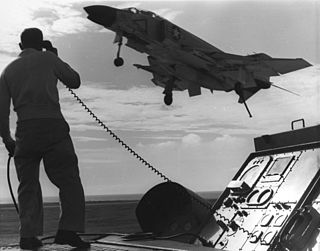
A landing signal officer or landing safety officer (LSO), also informally known as paddles or batsman, is a naval aviator specially trained to facilitate the "safe and expeditious recovery" of naval aircraft aboard aircraft carriers. LSOs aboard smaller air capable ships that launch and recover helicopters are informally known as deck. Originally LSOs were responsible for bringing aircraft aboard ship using hand-operated signals. Since the introduction of optical landing systems in the 1950s, LSOs assist pilots by giving information via radio handsets.

A modex is a number that is part of the Aircraft Visual Identification System, along with the aircraft's tail code. It usually consists of two or three numbers that the Department of the Navy, U.S. Navy and U.S. Marine Corps use on aircraft to identify a squadron's mission and a specific aircraft within a squadron. These numbers are painted conspicuously on the aircraft's nose—or, on helicopters, sometimes on the aft portion of the fuselage or forward portion of the empennage. Modexes are also painted less conspicuously on other aircraft areas. Shore-based aviation units use either two-digit or three-digit modexes, while carrier-based units always use three digits.

Jackson Dominick Arnold was a four-star admiral in the United States Navy who served as Chief of Naval Material (CNM) from 1970 to 1971.

Fighter Squadron 12 or VF-12 was an aviation unit of the United States Navy. Originally established on 9 January 1943, it was disestablished on 17 September 1945. It was the first US Navy squadron to be designated as VF-12.

Carrier Air Wing Six (CVW-6) was a United States Navy aircraft carrier air wing whose operational history spans from the middle of World War II to the end of the Cold War. Established in 1943 as Carrier Air Group Seventeen (CVG-17), it would be re-designated several times during its establishment, including Carrier Air Group Six (CVG-6) as the second unit to be so designated. The first Carrier Air Group Six served for just over two years during World War II, but drew on the history of the Enterprise Air Group established in 1938 and active in the early battles of the Pacific War, being disestablished after the first year of the conflict. During its time in USS Enterprise (CV-6), it was the Navy's only carrier-based air group to carry out three complete tours of duty during World War II.

The United States Navy (USN) is the maritime service branch of the United States Armed Forces and one of the eight uniformed services of the United States. It is the largest and most powerful navy in the world, with the estimated tonnage of its active battle fleet alone exceeding the next 13 navies combined, including 11 allies or partner nations of the U.S. as of 2009. It has the highest combined battle fleet tonnage and the world's largest aircraft carrier fleet, with 11 in service, 1 undergoing trials, two new carriers under construction, and six other carriers planned as of 2024. With 336,978 personnel on active duty and 101,583 in the Ready Reserve, the U.S. Navy is the third largest of the United States military service branches in terms of personnel. It has 299 deployable combat vessels and about 4,012 operational aircraft as of July 18, 2023.
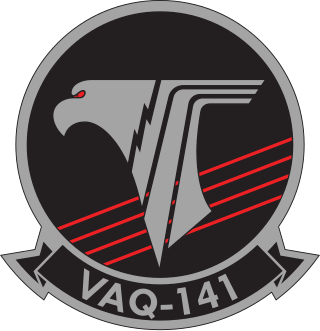
Electromagnetic Attack Squadron 141 (VAQ-141), also known as the "Shadowhawks", is an EA-18G Growler squadron of the United States Navy that is based at Marine Corps Air Station Iwakuni, located in Iwakuni, Yamaguchi, Japan. VAQ-141 falls under the cognizance of Commander, Electromagnetic Attack Wing Pacific (COMVAQWINGPAC) and flies in support of Carrier Air Wing 5 (CVW-5) aboard the Nimitz-class aircraft carrier, USS Ronald Reagan (CVN-76).
A ship's company or complement comprises all officers, non-commissioned officers and enlisted personnel aboard a naval vessel, excluding civilians and guests.
Fighter Squadron 15 or VF-15 was an aviation unit of the United States Navy. Originally established on 1 September 1943, it was disestablished on 20 October 1945. During six months of combat in 1944 the squadron destroyed more enemy planes than any other squadron in the Pacific War. Twenty-six of the squadron's pilots became aces.
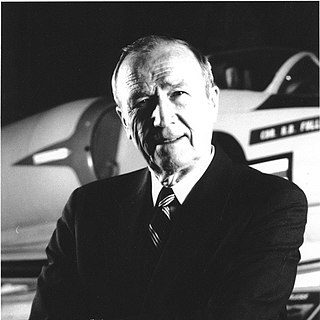
Donald Davenport Engen was a United States Navy vice admiral, former Administrator of the Federal Aviation Administration (FAA) and former Director of the National Air and Space Museum.
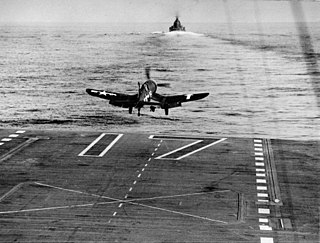
Fighter Squadron 84 or VF-84 was an aviation unit of the United States Navy. Originally established on 1 May 1944, it was disestablished on 8 October 1945. It was the first US Navy squadron to be designated as VF-84.
